Last season champions, Jeonbuk Motors, have again started the K-League 1 campaign on a strong note leading the second-placed and last season’s runner up, Ulsan Hyundai by one point. Pohang Steelers themselves are having a decent season losing only to FC Seoul and Ulsan Hyundai leading to this high-voltage fixture.
The Steelers boast of a tremendous attacking lineup who have scored 13 goals in seven matches, sitting just behind Ulsan Hyundai on the goal-scoring chart whereas the Warriors have conceded the least goals leading to this fixture. The match was supposed to be a tough battle between the two and it surely did not disappoint.
Let’s focus on the xG of both the teams before diving into the analysis. Jeonbuk Motors registered a massive 2.48 xG whereas Pohang had a mere 0.41. A simple question arises, how can someone term this as a hard-fought battle?
This tactical analysis will reveal the answer to the question detailing the tactics used by both the managers and where exactly Pohang lost the battle.
Lineups
Kim Gi-Dong reverted to four-man backline where they secured a huge win and the gaffer had no intention to tinker with it in this massive fixture. However, Pohang had a colossal setback. The Steelers were without their captain, Young-Jun Choi, who was loaned from Jeonbuk and was ineligible to face his parent club. Seung-Mo Lee replaced him as the defensive midfielder. Otherwise, Pohang had similar look to their lineup.
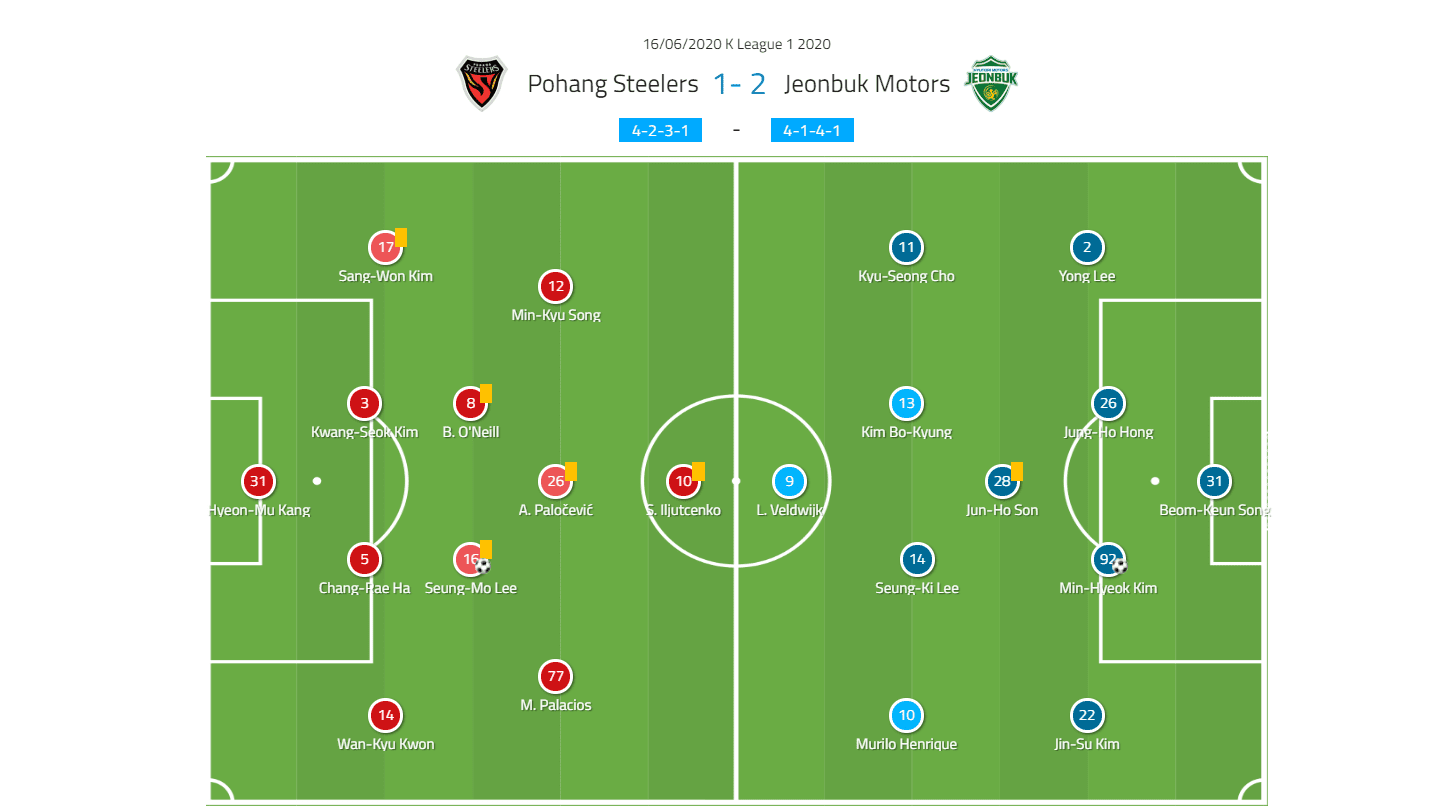
José Morais stuck to his preferred 4-1-4-1, however, he faced a similar conundrum. The Portuguese was without his captain and leading scorer, Dong-Gook Lee, who was away to pursue his AFC A-Level coaching license. He was replaced by the South African Lars Veldwijk.
Regardless, José Morais was happy to call back Chang-Rae Ha, who missed the previous two matches through suspension. The other two changes to the lineup were, Murilo Henrique replaced Sung-Yoon Lee in the left-wing and Kyu-Seong Cho replaced Kyo-Won Han in the opposite flank.
Well-coordinated pressing of both teams
The Steelers and the Warriors were bang on with their pressing and both the teams limited each other’s build-up significantly. Both the teams had only 37 positional attacks altogether. This validates the point above. Now, let’s dive deeper into the pressing structures.
Pohang Steelers
Jeonbuk is known to be a possession-based side, who builds-up in a very unique way by forming a diamond on the flanks. However, the Steelers were up to their task and almost eradicated the Warriors’ build-up significantly.
The Steelers gave free passing options to their centre-backs but man-marked every other player in the middle. The centre-backs had only Veldwijk to deal with.

The above image depicts how each player of Pohang marks the opposition. The centre-forward (CF) protects the central passing lanes and roams around in the final third with respect to the ball carrier and the other man-marks their respective opposition players. The pass wide to the full-back is the pressing trigger for Pohang. When the ball is passed to the LB of Jeonbuk, the RW of Pohang aggressively presses the LB inwards, i.e. protecting diagonal balls to the central channels forcing him to either play straight to LW or backward. However, the first potential safe option to pass back to the LCB becomes a dangerous one, since the CF is now in very close proximity to the LCB.
The main idea of Kim Gi-Dong was to mark the Jeonbuk midfielders closely since that is where Jeonbuk defeats the opposition. Kim did his homework and instructed his CAM, Aleksandar Paločević (or sometimes any other player who is in close proximity) to mark Jun-Ho Son profusely since he is generally the anchor of the diamond and is the starting point of almost every Jeonbuk build-up.
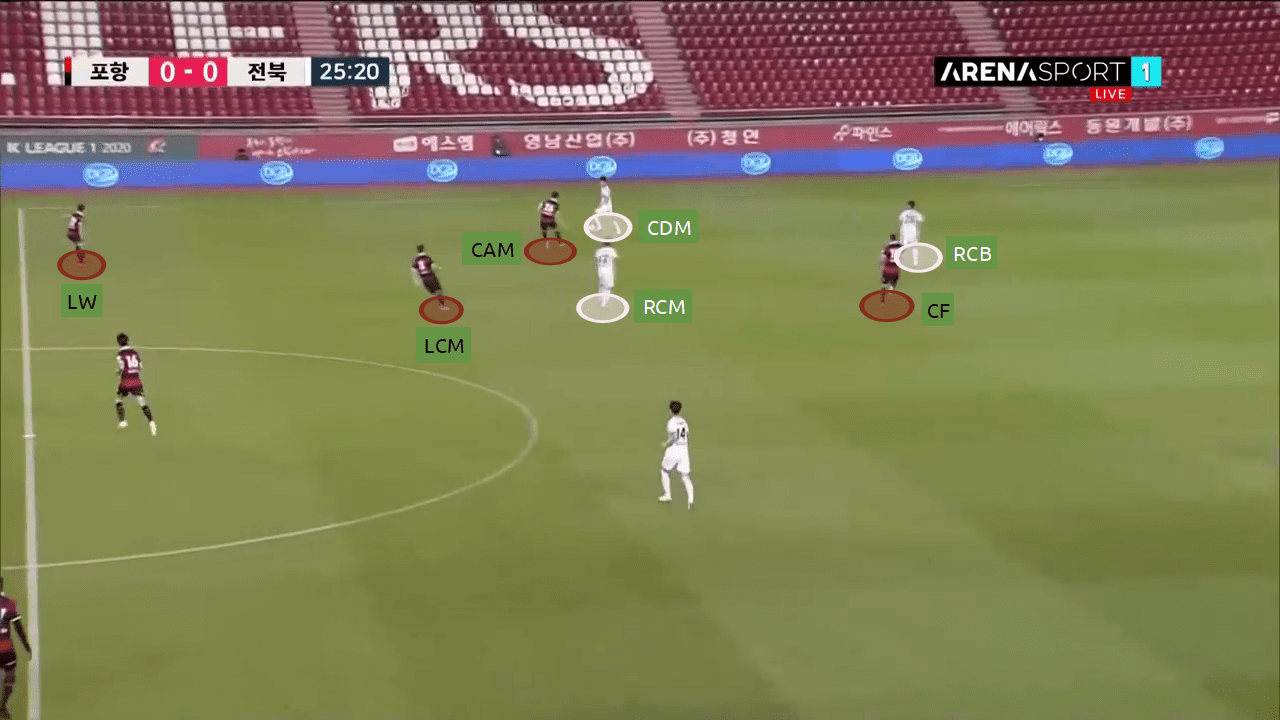
In this image above, Son moves to the right flank and pushes the RB up and Kim Bo-Kyung (former Wigan (Championship) and Cardiff City (Premier League) player), RCM, drops deeper which Jeonbuk normally do. However, when Son moves towards the right flank, Paločević follows him and Kim was followed by Brandon O’Neill who is the LCM. Even Stanislav Iljutcenko (CF) now covers the RCB, Hong. Son has no other option but to pass the ball forward to the Jeonbuk RB, Lee. When he does that, the Pohang LB aggressively presses him from the front and LW presses him from the back and wins back the ball.
The use of the diamond was mostly negated by Pohang. Jeonbuk tried to tweak their tactics frequently but the Steelers were up to the task.
Jeonbuk Motors
Jeonbuk too followed the same approach as Pohang Steelers but they were a bit more aggressive in their man-marking which can be understood by Warrior’s 8.1 PPDA (Passes Allowed per Defensive Actions). However, their task was less tedious and confusing since Pohang did not rotate much. The basic idea of Jeonbuk’s pressing was to always protect the central channels and to force Pohang towards the flanks or force them to play long.
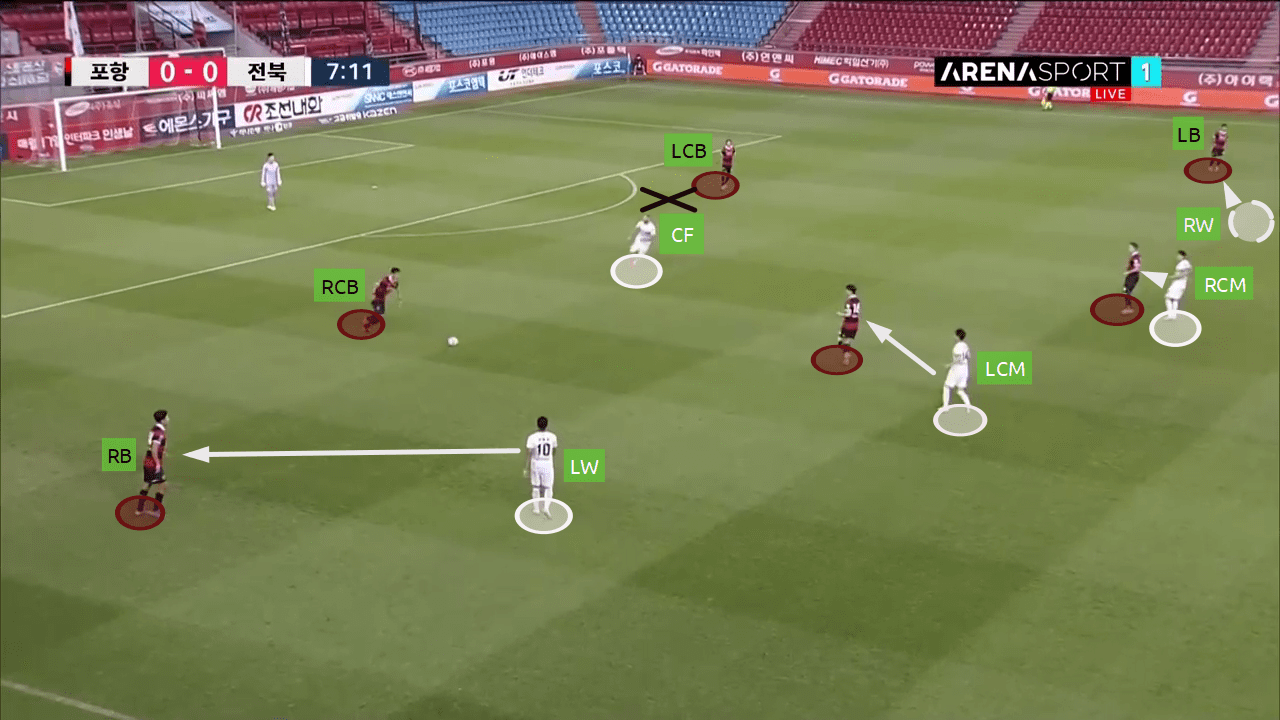
Here, Pohang’s RCB has the ball. Veldwijk shadow covers the LCB to protect the lateral passing lane and the other players closely mark the short passing options (RW out of frame). It forces the Pohang RCB to play long and Pohang loses the ball.
The other aspect of Jeonbuk’s pressing is when any Pohang player is able to slip out of the tight marking and positions himself in between the lines, one of the defenders come out of his line and marks him aggressively.
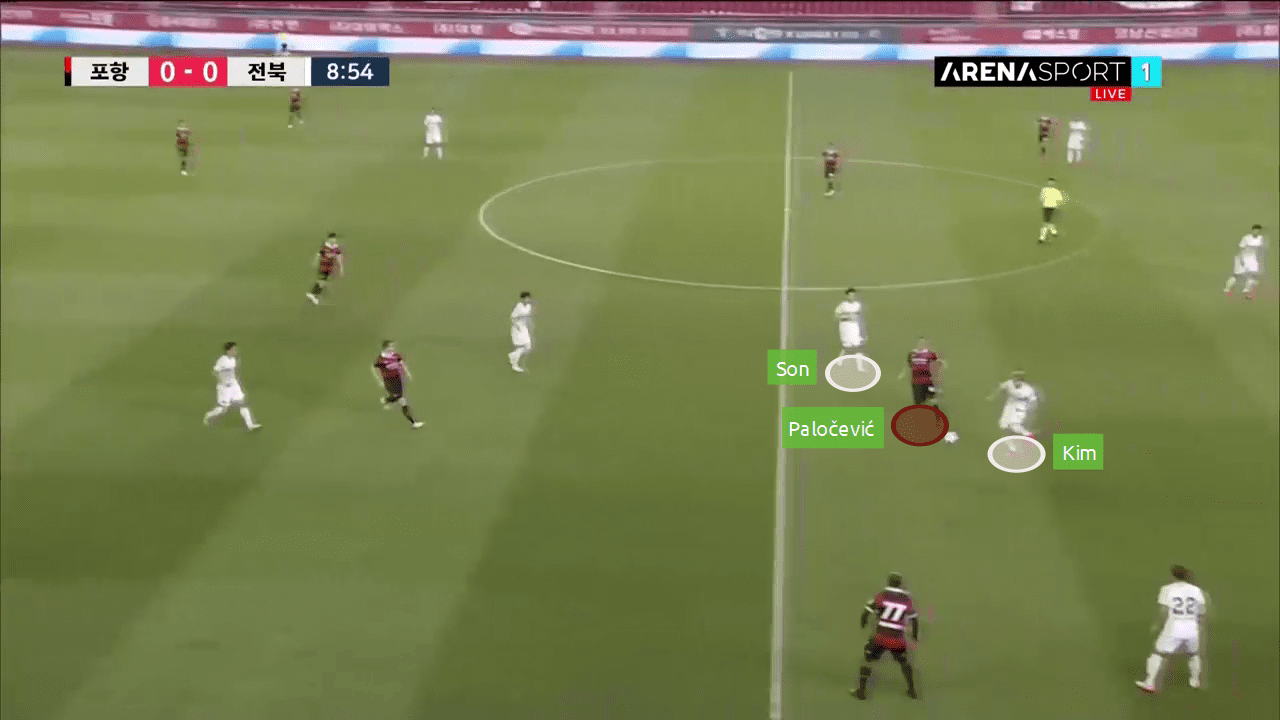
Here, Paločević slips out of Son’s marking and Pohang’s RB is able to find a pass to him. However, Jeonbuk’s LCB, Min-Hyeok Kim comes out of his line and intercepts the ball.
Jeonbuk’s tweak in tactics and Pohang’s adaptations
I will briefly discuss how Jeonbuk prefers to build-up before I get into how the Steelers negated their build-up.
Generally, CDM, Son is the anchor. RB, Yong Lee, moves up and is widest on the flanks (as shown by the dotted circle). LCM, Seung Ki-Lee is on the left side, and RCM, Kim forms the top of the diamond. They overload the right flank, generally 4 vs 3, and progress the ball with the 5th man ahead of them.
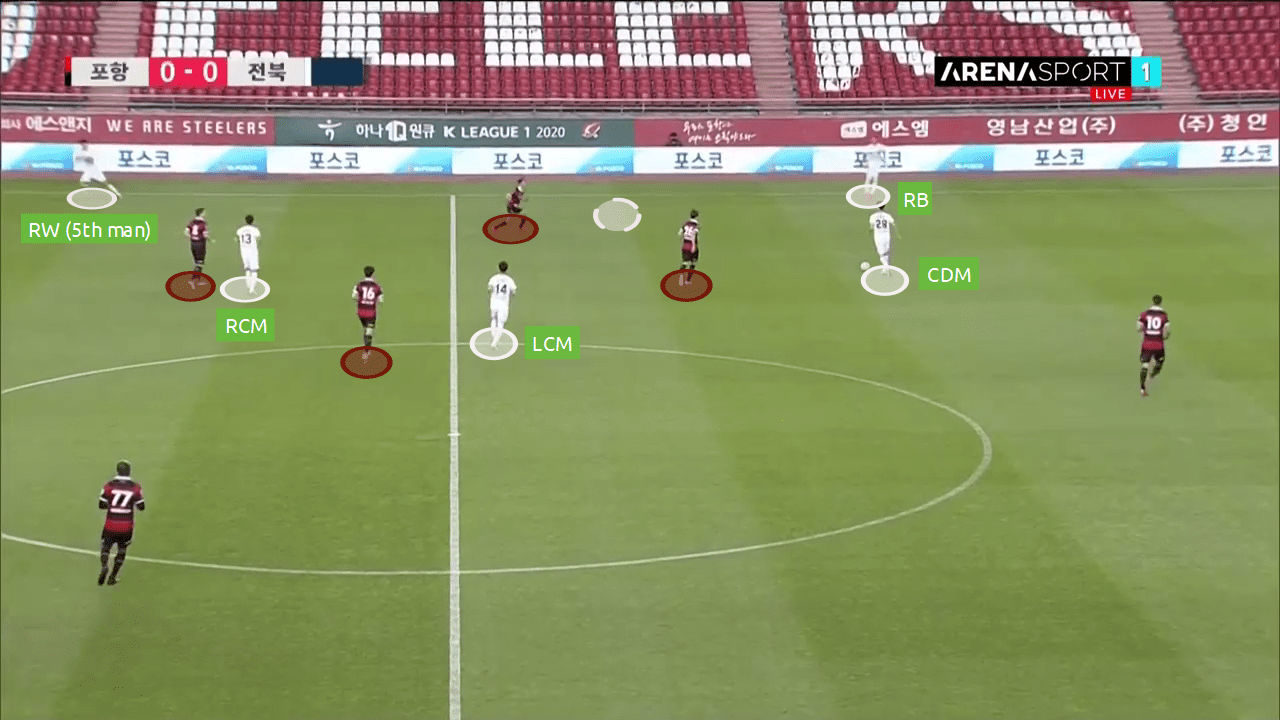
You can see a similar structure in the above image. However, due to Pohang man-marking and LW closely marking RB, Yong Lee has to fall back and make space for himself to receive the ball, and thus Pohang overloads the area with an extra man.
Jeonbuk unable to form the diamond, tweaks their style. Since Son is closely followed by Paločević all the time, he decides to maintain his position and does not go towards the right flank. RCB, Hong, now progresses the ball to the flanks and then looks for his passing options. However, Kim and Seung-Ki Lee occupy the right vertical half as they generally do to overload the flank.
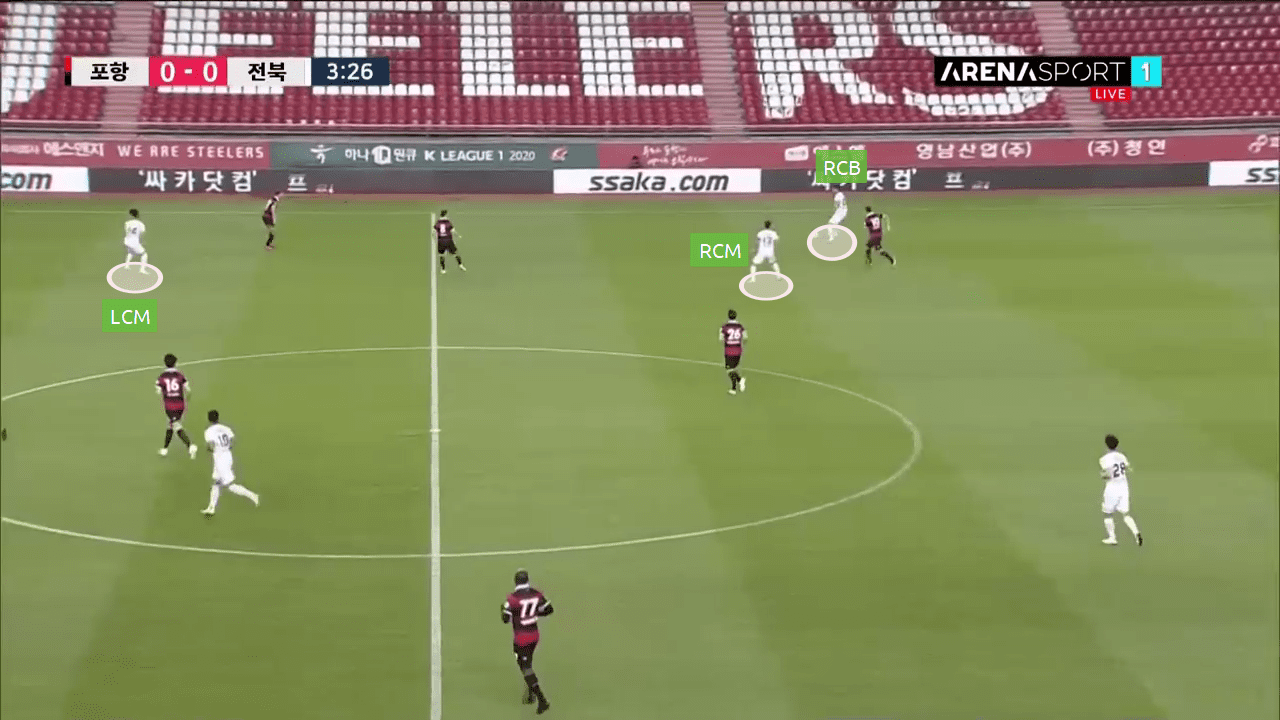
Yong Lee (RB), moves up furthest in the flanks acting almost as a winger. RW, Cho, inverts and positions himself in the half-space in between the lines. However, when a long ball is played to him, the Pohang LCB, Kwang-Seok Kim moves up the line and presses him aggressively as shown in the image below.
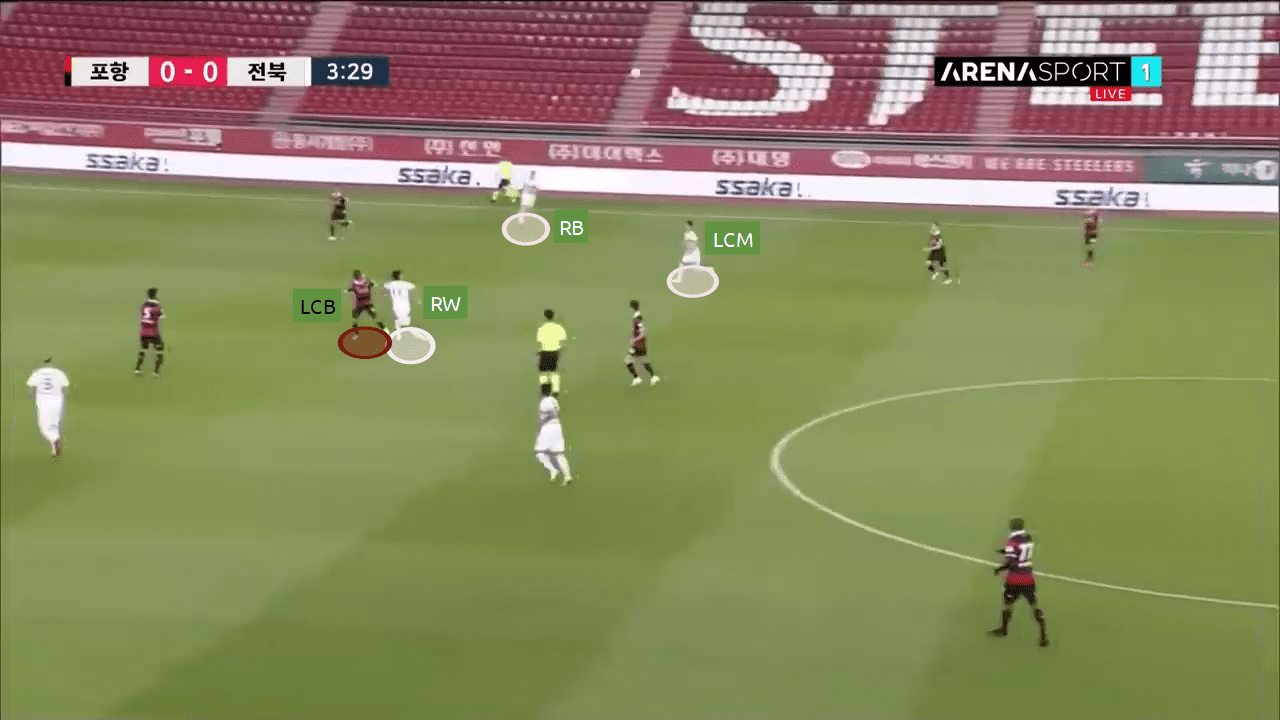
However, the Warriors were not always unsuccessful in building-up from the back. Few rotations did work in their way. Paločević closely marked Son (CDM), but there were some times when he had to let go of Son and mark the other player in the same position which usually Son occupies.
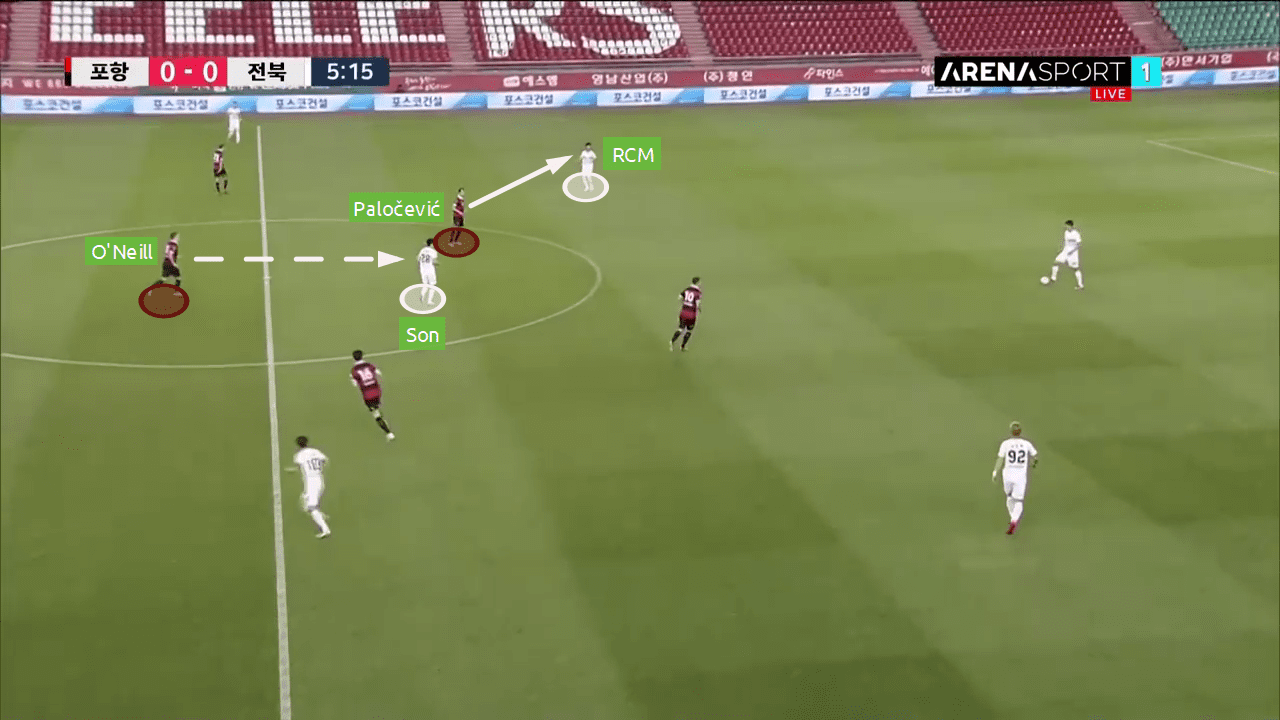
Here, Jeonbuk were switching the channel from left to right and the RCM dropped deep towards the flank which Son usually occupies. Paločević had to let go of Son and mark the RCM, hoping, O’Neill to mark Son who was in very close proximity to the midfielder.
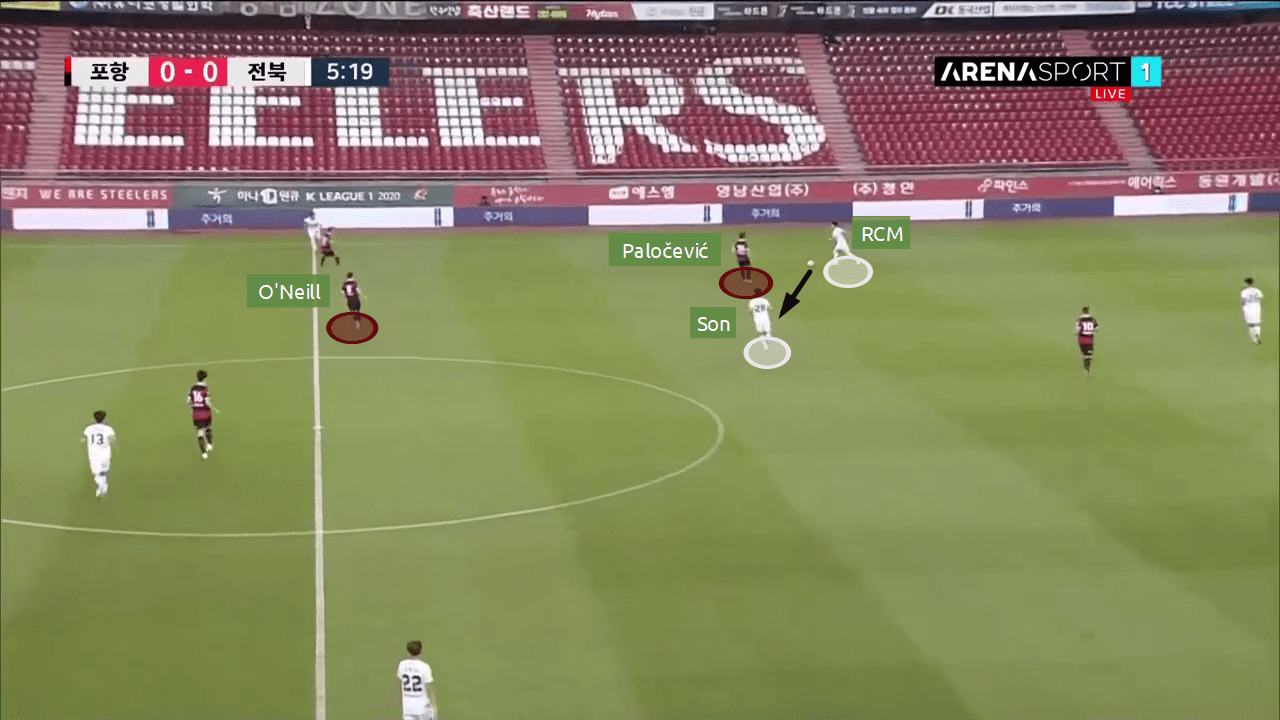
However, O’Neill miscommunicates and decides to move back to his position and leave Son free to receive a pass in a lot of unhindered space and progress the ball.
This is why co-ordinated jumps are so essential while pressing especially in man-marking. One single miscommunication can ruin the entire press.
Even though Jeonbuk had 24 positional attacks, they could hardly reach the Pohang final third. The Warriors had only three shots from positional attacks, the least in this campaign.
Pohang troubles Jeonbuk through counter-attacks
Jeonbuk did not force themselves in the Pohang box much but whenever they did, they hunted in packs. However, it made the Warriors’ defensive transition very dangerous.
Whenever Jeonbuk attacked the opposition box, they had huge numbers in the final third. Most of the time eight players would be in the final third or at the edge of the final third, with only two centre-backs shielding the defence. However, they did not close the distance between the midfield line and rather positioned themselves at the edge of the halfway-line. This distance caused them a huge problem, especially in the first half.
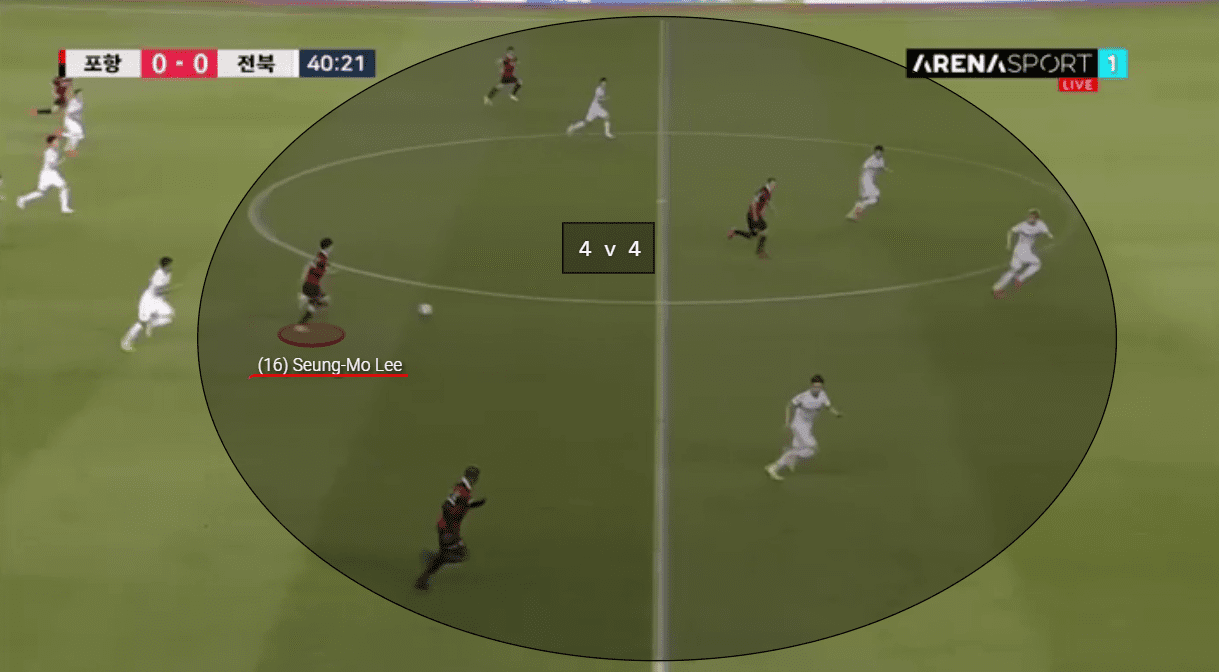
Here, Jeonbuk lost the ball after the LB, Jin-Su Kim put a cross inside the box. A Pohang player cleared the ball and it fell on the feet of Seung-Mo Lee. The LB and the RB dropped back in time and created a 4 v 4 situation with the midfielders playing the catch-up game. The midfielders lost the catch-up game and the Steelers opened their account.
In the later part of second-half, Jeonbuk tried to rectify their mistake and shortened the gap between their midfield line and the defensive line by either positioning Son a bit deeper or one of the centre-backs moving high to intercept when the ball reaches the supposed space in between the lines.
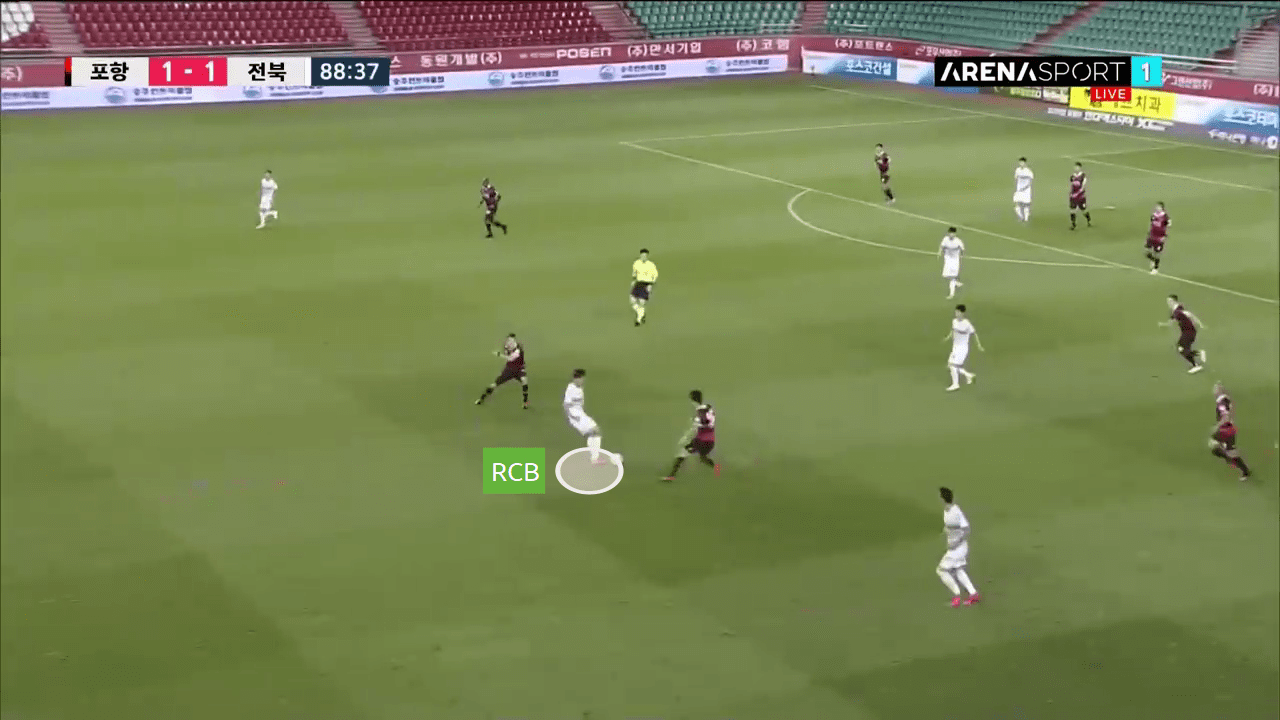
In the image above, eight Jeonbuk players were in the final third or at the edge of the final third. Jeonbuk lost the ball and Pohang expected a brilliant counter-attack, with three players looking to burst with pace to counter. However, the RCB moved up almost in the final third and intercepted the ball.
This is a risky move that could have gone against them any other day. However, this was the best way that the Warriors could have avoided the Pohang counter-attacks on that day.
Pohang’s set-piece conundrum
In the introduction part, I had mentioned, Jeonbuk had 2.48 xG compared to Pohang’s 0.41. If Jeonbuk were not able to build-up or counter-attack, how did the Warriors had a massive xG? The answer lies in set-pieces. Jeonbuk had 4 shots through set-pieces with three shots accumulating to 1.65 xG.
Pohang throughout this season struggled through set-pieces. In the match against FC Seoul, the Steelers conceded two goals through corners and lost the match 2-1.
In set-pieces, generally, all the teams, protect their GK zone, since this is the zone that gives a higher probability of scoring. However, Pohang seem to struggle defending corners in the GK zone as well as leaves the back-post empty most of the time. This is where Jeonbuk took full advantage.
The first corner which the Warriors took, they tried a similar pattern in three more occasions with one resulting in the winner for Jeonbuk.
Pohang use a structure which various teams use in defensive corners, a mix of zonal and man-marking. Generally, in this game, they used five zonal markers and five man-markers.

One zonal marker tugged to the near post, one stayed a bit ahead of him to prevent any flicks to the far-post. The other three positioned themselves centrally. One vertically parallel to the near-post, another parallel to the far-post, and another in between the two. The two man-markers at the edge of the box marking the two Jeonbuk players. Manuel Palacios marking Veldwijk and the other two markers marking three Jeonbuk players in a cluster. Generally, the aim of the zonal markers is to cover the six-yard box as much as possible and thus the spacing between the zonal markers is absolutely key.
Pohang neither have optimal spacing nor have a near-post player in a proper position to avoid any flick to the far-post. It allows the opposition to exploit the areas which should always be protected. In the image above, if you notice, the distance between the central zonal marker and the far-post zonal marker is too huge, and also the player protecting the near-post should be more ahead to prevent any opposition to exploit that space.
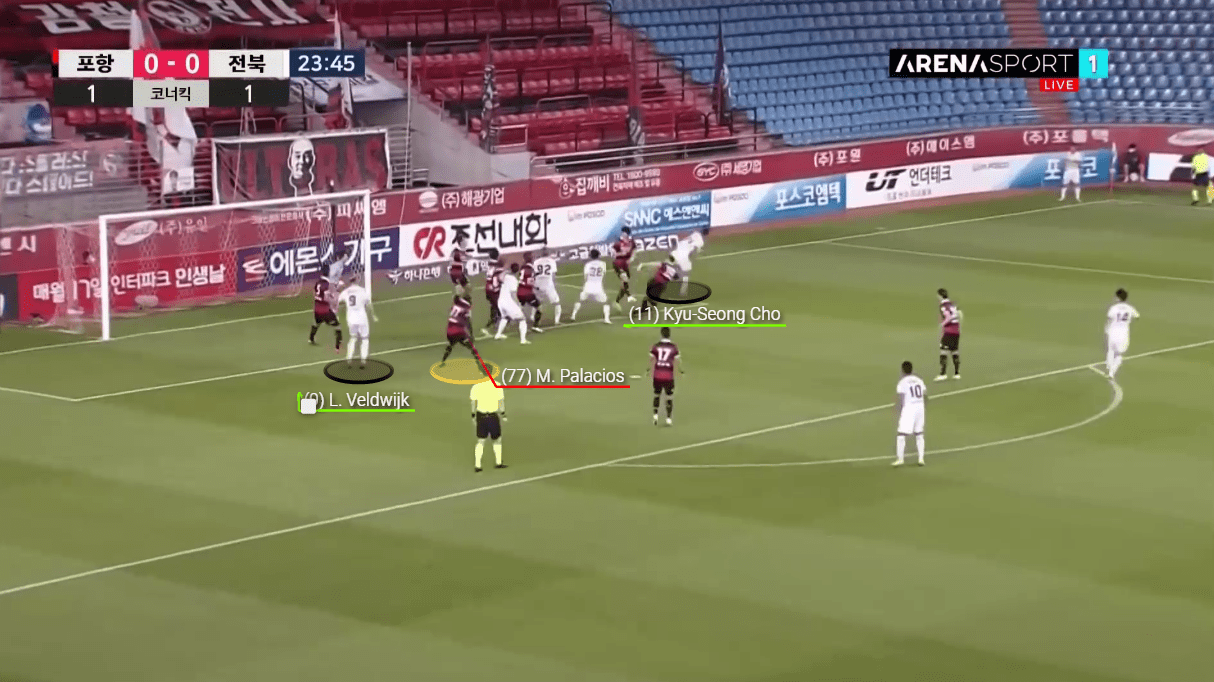
In the image above, the two Jeonbuk players moved to the near-post region with the intention of flicking the ball to the far-post. However, the delivery was perfect and Cho headed the ball and it hit the post. Also, notice how Palacios is easily beaten by Veldwijk and the South African could have easily scored if the ball was flicked to the far-post.
However, they scored from the same pattern of play in the injury time after trying it for another two times in the game.
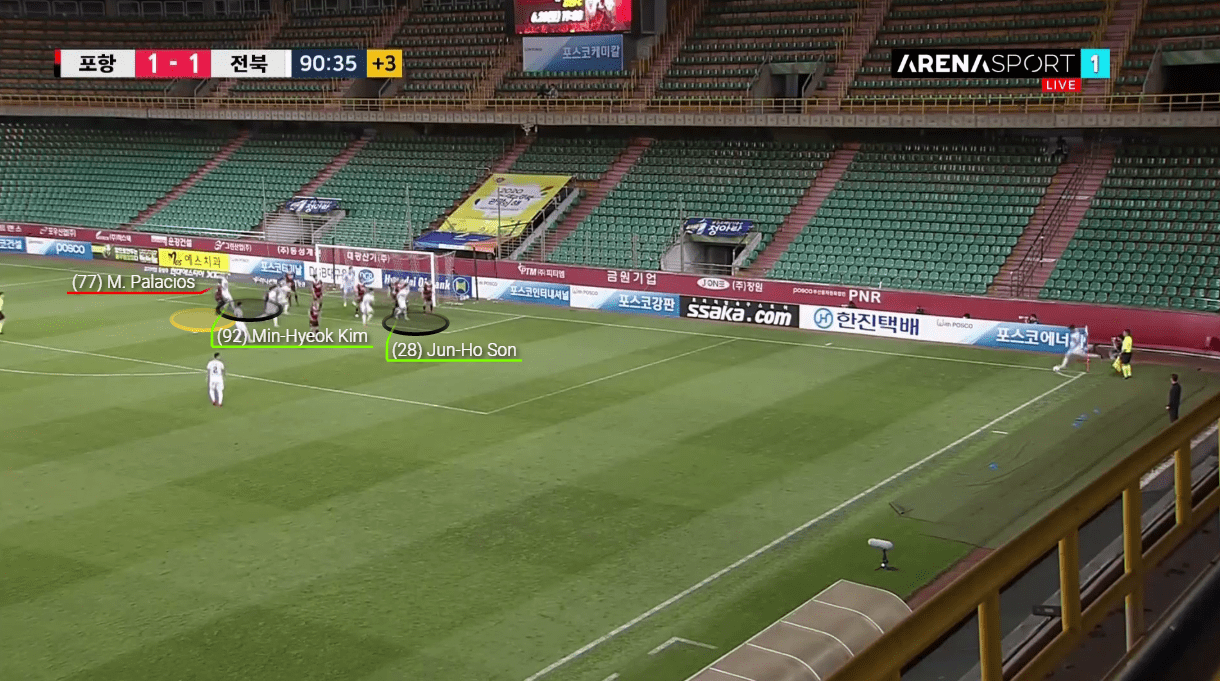
Here, Son is already positioned in the near-post to flick it to the far-post and no Pohang player is pushing him out, and also note Min-Hyeok Kim is man-marked by Palacios for this corner.
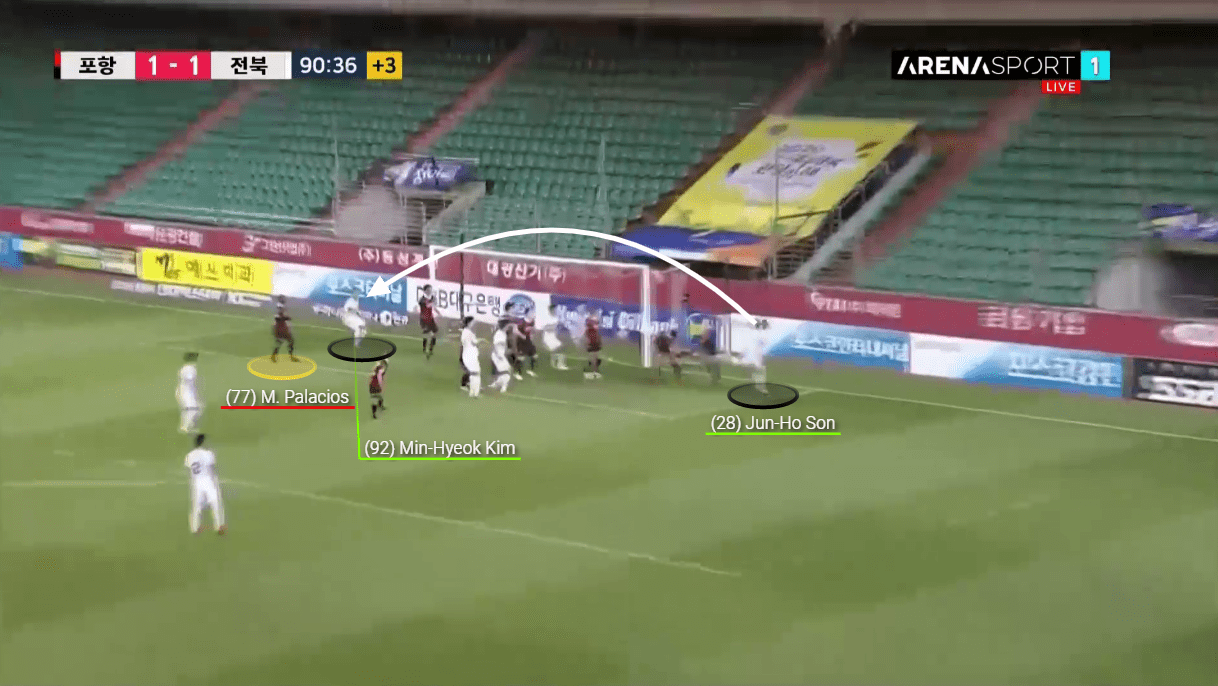
Since no one pushes Son out, he easily flicks the ball to the far-post. Palacios caught napping and loses his man, Kim. Kim slots it home from a very close range to win all three points for the Warriors.
In these corners there were few basic errors. Pohang did not have optimal spacing between the zonal markers, the position of the near-post zonal marker to prevent the flick was awful and Palacios is a poor man-marker. Jeonbuk did not even have to try using blockers to exploit Pohang from set-pieces.
Pohang are also vulnerable in the GK zone immensely. Jeonbuk put one corner in the GK zone and the substitute Takahiro Kunimoto headed it off-target (which won’t be discussed in this analysis).
Conclusion
The match was an evenly fought affair if not for set-pieces. It’s often said in a tight game, set-piece becomes a differential factor and Jeonbuk proved it to perfection.
Morais should focus on improving Jeonbuk’s defensive transitions. The Warriors get hit quite a lot with counter-attacks and if Pohang have any intention to play in the Champions League, they better put more effort into set-pieces. Any team can exploit Pohang from set-pieces if Kim-Gi Dong doesn’t tinker with his defensive formation in set-pieces.
Jeonbuk cemented their position at top of the league and Pohang drops down a place to occupy the 5th position after game-week 7.






Comments